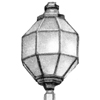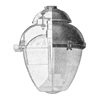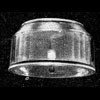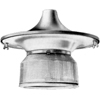
|
Refractor Plate
The Holophane refractor plates are designed with a prismatic optical system which controls 180° of
the light rays emitted in the mid-zone, refracting the upwardly emitted light in a lateral direction, and
giving a two-way directional lighting system of two main beams of an intensity of four to six times the
candle-power of the burner. The prismatic plates as fitted do not affect the normal light distribution
from the burner for the zone 0°-70° from the nadir; the control being obtained from the rays
emitted horizontally and upward. The increase of candle-power intensity secured at the wide angles from
70° to 85° is therefore obtained from the light not normally used for street illumination. These
plates, which form a one-piece asymmetric refractor, can be arranged in any formation to give a one, two,
three, four or circular light distribution. This application of the directional system to gas lanterns is
something entirely new, and constitues one of the most radical innovations shown at Sheffield. The development
of these units will eb watched with considerable interest, as it seems possible that they may exercise a
marked influence on the future of the public lighting with gas.
|
|
???
|
Single/Multiple burners
|
Asymmetrical
|
???
|
???
|
1928 Journal
|
Square gas lantern
|
|

|
Band Type Symmetrical
Gives a form of light distribution more suitable for spacing on wider thoroughfares. This
form of refractor is generally fitted inside lanterns with clear glass bowls. A new band-type
refractor has recently been designed giving a two-way directional distribution
|
|
4431
|
60-100W
|
Symmetrical
|
70°-80°
|
n/a
|
1920s Catalogue
1928 Journal
|
ELECO Glasgow
|
|
4432
|
150-300W
|
Symmetrical
|
70°-80°
|
n/a
|
1920s Catalogue
1928 Journal
|
ELECO Glasgow
Holophane 552
|
|
4439
|
500-750W
|
Symmetrical
|
70°-80°
|
n/a
|
1920s Catalogue
1928 Journal
|
ELECO Glasgow
Holophane 555
|
|

|
Dome Type Symmetrical
These are also for lanterns equipped with outer globes. It is not made with diffusing prisms,
the necessary diffusing of the light rays being effected by the outer globe, which is made in rippled
or frosted glass. Dome-type refractors are also being made with an asymmetric light distribution, so
as to redirect the maximum amount of light away from the house line to the roadway proper.
|
|
4434
|
100-200W
|
Symmetrical
|
70°-80°
|
n/a
|
1920s Catalogue
1928 Journal
|
Holophane 542
|
|
4435
|
300-500W
|
Symmetrical
|
70°-80°
|
n/a
|
1920s Catalogue
1928 Journal
|
Holophane 545
|
|

|
|

|
|

|
|

|
|

|
|

|
|

|
|

|
|


|
|


|
|

|
|


|
|


|
|
|
|
Prismatic Refracting Panel
Gives very wide lateral light distribution without "glare" and with exceptional visibility.
The prismatic panels are constructed in two pieces with the prisms formed internally so that both
exposed surfaces are smooth. Available with 160° and 180° spread between the main beams.
|
|
???
|
250W-400W MA
|
???
|
???
|
???
|
1944 Journal
|
Siemens Regent-Sieray
Siemens Barnet-Sieray
|
|

|
Prismatic Refracting Panel
Gives very wide lateral light distribution without "glare" and with exceptional visibility.
The prismatic panels are constructed in one piece with external prisms.
A single refractor
is the length of a 45-60W SO/H lamp so two were used in-line for the higher wattages.
|
|
771
|
150W SO/H
|
???
|
???
|
???
|
1940s Catalogue
|
1936 Advert
BLEECO Streamline
|
|
|
|
|
|
|
Prismatic Refracting Panel
Gives very wide lateral light distribution without "glare" and with exceptional visibility.
This could be an improvement of the 780, being introduced in 1939. The prismatic panels are constructed
in two pieces with the prisms formed internally so that both exposed surfaces are smooth. A single refractor
is the length of a 45-60W SO/H lamp so two were used in-line for the higher wattages. Also called the
Duo-Plate Sodium Refractor in adverts.
|
|
781
|
150W SO/H
|
???
|
???
|
???
|
1939 Programme
1940s Catalogue
|
Holophane Lineal
BLEECO Streamline
|
|

|
|
|
|
|
|
|
|
|
|
|

|
|

|
Stepped Bowl Refractor

 Bowl refractor constructed from one piece of glass. Has internal exposed prisms with
smooth exterior. Designed for use with GLS lamps and either the 4118, 2/4118 and 22/4118 dome refractor.
Bowl refractor constructed from one piece of glass. Has internal exposed prisms with
smooth exterior. Designed for use with GLS lamps and either the 4118, 2/4118 and 22/4118 dome refractor.
Polar curves and iso-candela diagram for 4119 bowl refractor with 2/4118 dome refractor
1953 Catalogue
| (With 2/4118 refractor) | GLS |
| Beam Angle Horizontal | 170° |
| Beam Angle Vertical | 77° |
| Light output ratio | 82% |
| Light flux in lower hemisphere | 85% |
| Directional Intensity Ratio | 2.8 |
|
4119
With 2/4118
|
300-500W GLS
|
Non-Axial
|
170°
|
77°
|
1940s Catalogue
1953 Catalogue
|
BLEECO Prismatic Bowl Refractor
Crompton Lion
|
|
|
|
|

|
|

|
Plate Refractor
Designed in 1947 especially for the Sugg Southport gas lantern. Has oval prisms of graduated shape which give a
lateral spread to the light distribution which is valuable in lighting curved roads or open spaces.
|
|
???
|
??? mantles (Gas)
|
???
|
???
|
???
|
1947 Programme
|
Sugg Soutport A
Sugg Soutport B
|
|



